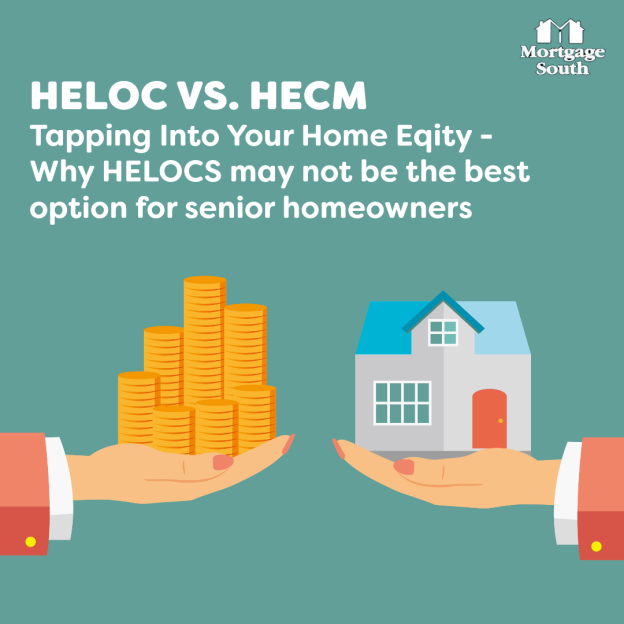When it comes to leveraging the value of a home, both a home equity line of credit (HELOC) and a home equity conversion mortgage (HECM, reverse mortgage) are options to tap into your home equity. However, a HELOC is not necessarily the most appropriate option for older homeowners, ages 62+.
HELOC vs HECM: How Do HELOCs Affect Borrowers?
Due to the unprecedented rise of interest rates that started in March of 2022, HELOC monthly payments have doubled, or in some cases tripled and created a strain on borrowers. We have received many calls about homeowners not being able to afford their HELOC payment anymore. Home equity lines of credit come with variable rates. This means that their rate can go up or down based on the decisions of the Federal Reserve — so even if our borrowers took out a HELOC with a low rate, they are now facing much higher interest rates on their monthly payments. Also, HELOC loans mature at either 5 or 10 year intervals. When they mature, the borrower must re-qualify or begin to pay back both principal and interest, typically over a 20 year period with full amortization. This can cause even higher payments and has even led to forcing the sale of the home or foreclosure. With most retirees on a fixed income, the increase in monthly payments at the end of the draw period can be an unwelcome surprise.
Why HELOCs May Not Be the Best Option for Senior Homeowners
Many borrowers in an older age bracket have managed the revolving debt for as long as possible, but now their savings have been depleted as interest rates continue to skyrocket. According to a new GOBankingRates survey of 1,000 people, about three out of four have savings accounts, but the biggest percentage by far — about one in three — have only $100 or less stashed away. American consumers are depleting the “excess savings” they accumulated during the COVID pandemic. Americans’ excess savings from the pandemic peaked at about $2.1 trillion in August 2021 but fell to roughly $500 billion as of this spring, according to estimates by economists at the Federal Reserve Bank of San Francisco.
This problem is most acute with older Americans because of the likelihood that they are on fixed incomes. Even high-yield savings are depreciating assets. Savers with the highest-yield accounts are growing their money at 4.5% while that money loses 7.6% of its buying power.
How Might HELOCs Reduce Your Available Assets?
Many people get a HELOC while they are still working to do home repairs, put a child through school, start a business, etc. —but the problem arises ten years later when they’re living on retirement cash flow that’s about 75-80% of what it used to be prior to retirement. And when their HELOC payment suddenly spikes up a few years after they’ve retired, it may create a serious cash flow problem. With HELOC payments doubling or tripling and savings/IRAs depleting, Americans (specifically older Americans) are really running into a cash crunch. Medical payments, revolving debts, and general inflation are snowballing into a potential bankruptcy looming over many seniors.
Why a Reverse Mortgage (HECM) May Be Your Best Option
This is why it is important to see a reverse mortgage as a financial planning tool, not a last resort. Many borrowers are refinancing from a HELOC to a reverse mortgage, once they realize it’s the better choice in the long run because with a HECM, seniors’ financial stability can’t be jarred by the possibility of a payment spike. A reverse mortgage is like few others you’ve experienced. You have no monthly payment and have access to a line of credit. It turns the equity you’ve built in your home into cash. Depending on the terms you select, you can receive monthly payments, a lump sum, or another payment option. However, it is similar to other loans in the sense that you still own your home, the property must be the borrower’s primary residence, and you still maintain taxes and insurance on the property. You can also sell your home at any time with no prepayment penalty or leave the property to your heirs.
Reverse mortgages are designed specifically to help seniors manage their cash flow. While payments may be piling up and inflation at the highest we’ve seen in four decades, taking out a home equity conversion mortgage, or a reverse mortgage, can be extremely beneficial. Perhaps the two biggest benefits of a HECM are that there are no monthly mortgage payments required and there will be a growing line of credit that can be accessed over the life of the loan. With the average monthly payment on a HELOC now hovering around $800-$1300, obtaining a reverse mortgage presents a major savings opportunity every month.
Contact Us for Help With Your Reverse Mortgage
Utilizing the equity in your home to fund your retirement is a viable option that benefits many seniors. The federally insured reverse mortgage, or HECM, enables homeowners to eliminate their existing monthly mortgage payment. At the same time, it offers a growing standby line of credit for future needs. If you think that a reverse mortgage is right for you – get in touch with Mortgage South today!



